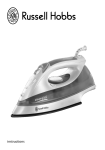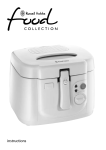Download Russell Hobbs JOYCE_RH_10950_IB_25-4-03 User's Manual
Transcript
Joyce_RH_10950_IB_25-4-03 4/25/03 10:29 PM Page 1 classic white range rice cooker instructions and guarantee Joyce_RH_10950_IB_25-4-03 4/25/03 10:29 PM Page 2 2 Joyce_RH_10950_IB_25-4-03 4/25/03 10:29 PM Page 3 Read these instructions before use and keep them safe. If you pass the rice cooker on, pass on the instructions too. Remove all packaging, but keep it till you’re satisfied the cooker is working. Important safeguards When using electrical appliances, basic safety precautions should be followed, including the following: 1.Don’t put the cooker body in water or any other liquid, don’t use the cooker in a bathroom or near any source of water, and don’t use it outdoors. 2.This appliance should be used only by or under the supervision of a responsible adult. 3.Don’t put frozen meat or poultry in the cooker — defrost fully before use. 4.Don’t try to cook anything in the body of the cooker — cook only in the removable pan or in the basket fitted above the pan. 5.Don’t fill the pan above the bottom of the 1.8 mark. If you do, it may spit boiling water. 6.Don’t touch the hot surfaces of the cooker, lid, or pan. 7.Use oven gloves or a cloth when handling the lid, or pan. 8.Steam escapes from the vent and rim, so don’t reach over the cooker. 9.Keep hands, arms, face, etc. clear of the escaping steam when lifting the lid or pan. 10.Remove the pan to serve. Don’t try to move the cooker. It’ll be heavy, and the mains lead will probably catch on something as you move. At best, you’ll tip the rice over the floor, at worst, you might scald yourself. 11.Position the cooker on a firm, level, heat resistant surface, close to a power socket, and out of reach of children. 12.Route the mains lead so that it doesn’t overhang, and can’t be tripped over or caught accidentally. 13.Don’t use the cooker near or below curtains, shelves, cupboards, or anything else likely to be damaged by the escaping steam. 14.Don’t cover the cooker or put anything on top of it during use. 15.Keep the cooker and mains lead away from hotplates, hobs and burners. 16.Unplug the cooker when not in use, before moving and before cleaning. Let it cool down fully before cleaning and storing away. 17.Don’t use accessories or attachments other than those we supply. 18.Don’t use the cooker for any purpose other than those described in these instructions. 19.Don’t operate the cooker if it’s damaged or malfunctions. If the mains lead or plug is damaged, the cooker must be returned in order to avoid hazard. Household use only Before using for the first time Wash the pan, lid, and rack in warm soapy water, rinse thoroughly and dry. This should wash away any manufacturing dust, etc. 3 Joyce_RH_10950_IB_25-4-03 4/25/03 10:29 PM Page 4 How it works Basically, you put food and water into the pan and leave it to boil dry. The cooker detects the boil-dry condition and switches to “keep warm” mode. There are two ways to regulate cooking times. 1.Use exactly the right amount of water, and leave the cooker to switch to Warm automatically — this is the method used to cook rice. 2.Use enough water, time the cooking, and move the switch up when it’s done. This is the easiest way to steam “unknowns”, unknown quantities, unknown vegetables, unknown sizes. When you use method 2, keep notes. Next time, you can use just the right amount of water, and leave the cooker to do the job on its own (method 1). Overcooking Steaming is relatively gentle, so overcooking isn’t normally a problem. Just don’t leave it too long (unless you like soggy veg), and take extra care with delicate foods like shellfish, which tends to go a bit rubbery if overcooked. Preparation 1.Sit the cooker on a firm, level, heat-resistant surface, close to a power socket, and out of reach of children. 2.Steam will escape, so don’t put it near curtains, under shelves or cupboards, or near anything that might be damaged by the escaping steam. 3.Have oven gloves (or a cloth) to hand, and a heat-resistant mat or dinner plate to put the pan or basket on after cooking. 4.Put the pan inside the cooker. Cooking rice 5.Some suppliers tell you not to wash rice, as it washes away nutrients. We recommend washing rice in cold water and letting it drain. This will remove excess starch and any loose bran. It also makes the cooked rice less sticky. 6.Fill the pan with the amount of rice required. 7.Add the required amount of water — generally, use 1 cup of water for each cup of rice. 8.Don’t fill past the 1.8 mark inside the pan. 9.Put the lid on the pan. 10.Plug the cooker in (switch the socket on, if switchable). The Warm light will come on. 11.Press the control down — it’ll lock in the down position, and the Cook light will come on. 12.When the rice is cooked, the control will pop up to its original position, the Cook light will go out, the Warm light will come on. 13.Let the rice rest for about 10 to 15 minutes, then unplug the cooker. 14.Put on the oven gloves. 15.Steam and hot air will escape when you lift the lid. Tilt it slightly to direct the steam away from you. 16.Lift out the pan and set it down on a heat-resistant mat or dinner plate. 17.Use the spatula to turn and mix the rice, to let all the steam escape. 4 Joyce_RH_10950_IB_25-4-03 4/25/03 10:29 PM Page 5 Additional ingredients If you add any additional ingredients (raisins, fruit, nuts, etc.), you should reduce the amount of rice to compensate for the amount of water they’ll soak up. As raisins and dried fruit will soak up as much water as rice, put them into the measuring cup along with the rice. Nuts won’t generally take up much water, so you can normally add them after you’ve measured the rice. Not ready to serve? You can leave the rice on the Warm setting while you prepare the rest of the meal, but try not to leave it for too long. After a couple of hours or so the rice will start to dry and the flavour will fall off. Don’t worry too much, it’ll still taste good, but it’ll be “good” instead of “great!”. Using the cooker as a steamer 1.Sit the rack on the bottom of the pan and lay the food on the rack. 2.Don’t leave food in the cooker after steaming — it’ll go soggy. 3.Follow items 1 to 4 under “Preparation” 4.Put the correct amount of water in the pan. 5.For uniform cooking, cut all pieces of food to roughly the same size. 6.Whole cabbage or cauliflower can sit on the rack. For sliced veg, peas, etc., or anything that’ll break up or droop into the water, make it into a parcel with aluminium foil, and lay the parcel on the rack. Take care when removing the parcel — wear oven gloves and use plastic tongs spoons. 7.Follow the Steaming times on page 7. Steaming 8.Fit the lid to the pan. 9.Plug the cooker in (switch the socket on, if switchable). The Warm light will come on. 10.Press the control down — it’ll lock in the down position, and the Cook light will come on. 11.When the food is cooked, the Cook light will go out, the Warm light will come on, and the control will return to its original position. 12.Unplug the cooker. 13.Put on the oven gloves. 14.Steam and hot air will escape when you lift the lid. Tilt it slightly to direct the steam away from you. 15.Lift out the pan (or basket) and set it down on a dinner plate. Timing The times given on page 6 are for a single layer of food. You’ll need to experiment to find the times which suit your favourite foods and food combinations. Ready? Cook fish till the flesh is opaque and can be flaked easily. Cook meat till the juices run clear. You should cook leaf vegetables as little as possible, to keep them green and crisp. Plunging them into iced water will stop the cooking process. 5 Joyce_RH_10950_IB_25-4-03 4/25/03 10:29 PM Page 6 Take notes Note the type and quantity of food and the amount of water. Next time, adjust the water and let the cooker look after the timing. General The plunger will prevent the element working unless the pan is in place. If you switch the cooker on accidentally, lift the pan off the element and set it down again to reset the control, or move the control up to its rest position (Warm). Steaming times (in minutes) These times assume a single layer of food in the basket. Food Time Food Time Asparagus (fresh, 400g) 15-18 Potatoes (400g, quartered) 25-30 Green beans (fresh, 200g) 20 Spinach (fresh, 200g) 5-8 Broccoli (200g) 18 Prawns (fresh, 400g) 6-8 Brussels sprouts (200g) 20 Mussels (fresh, 400g) 8-10 Cabbage (quarter head) 25-30 Lobster tail (frozen, 2 pieces) 20-23 Carrots (sliced, 200g) 15-20 Fish fillets (fresh, 250g) 10-12 Courgette (sliced, 200g) 10-12 Fish steaks (fresh) 12-15 Corn cobs (fresh, 2 cobs) 25-35 Chicken (fresh boneless 250g) 15 Care and maintenance Unplug the cooker and let it cool down fully before cleaning. Wash the lid, pan, and rack in warm, soapy water, rinse and dry. Don’t put any part in a dishwasher, it will affect the surface finishes. Wipe the cooker, inside and out, with a clean damp cloth. Stubborn stains may be removed with a little washing-up liquid, but make sure you remove all trace of it before using the cooker. Don’t put the cooker in water or any other liquid. Don’t use harsh or abrasive cleaning agents or solvents. 6 Joyce_RH_10950_IB_25-4-03 4/25/03 10:29 PM Page 7 Connection to the mains supply The appliance must be earthed. It’s supplied with threecore mains lead and a 13A plug complying with BS1363. To replace the fuse, use a 13A ASTA or BSI approved fuse conforming to BS1362. If the plug needs replacing The Green/Yellow wire (Earth) goes to the terminal marked E or , the Blue wire (Neutral) goes to the terminal marked N, the Brown wire (Live) goes to the terminal marked L. Secure the cord grip. If in doubt, call an electrician. If the plug supplied is non-rewireable (moulded) Don’t use the plug without the fuse cover in place. If you need to remove the plug, dispose of it. To avoid electric shock, don’t re-use it or put it in a socket. After sales service The appliance isn’t user–serviceable. If it’s not working properly, check: 1.You’ve followed the instructions correctly. 2.The plug fuse hasn’t blown. 3.The main supply fuse/circuit breaker hasn’t blown/tripped. If it still doesn’t work, consult your retailer. If your retailer fails to solve your problem, and you need to return it to us, proceed as follows: 1.Pack it carefully. 2.Enclose your name, address, and daytime telephone number. 3.Tell us what’s wrong with it. 4.If under guarantee, state where and when bought, and include proof of purchase (e.g. till receipt). 5.Send it to Customer Service Dept, at the address at the end of this leaflet. 6.They’ll give you an estimate for inspection/repair. 7 Joyce_RH_10950_IB_25-4-03 4/25/03 10:29 PM Page 8 Guarantee Any defect affecting the functionality of the appliance which becomes apparent within one year of its purchase will be corrected by free repair or replacement provided that it has been used and maintained in accordance with the instructions and has not been abused or misused in any way. Your statutory rights are not affected. In line with our policy of continuous product development we reserve the right to change product, packaging and documentation specifications without notice. Customer Service Department ([email protected]) Salton Europe Ltd, Failsworth, Manchester M35 0HS England www.eSaltoneurope.com Telephone 0845 658 9700 (calls charged at local rate) 436-457 8












